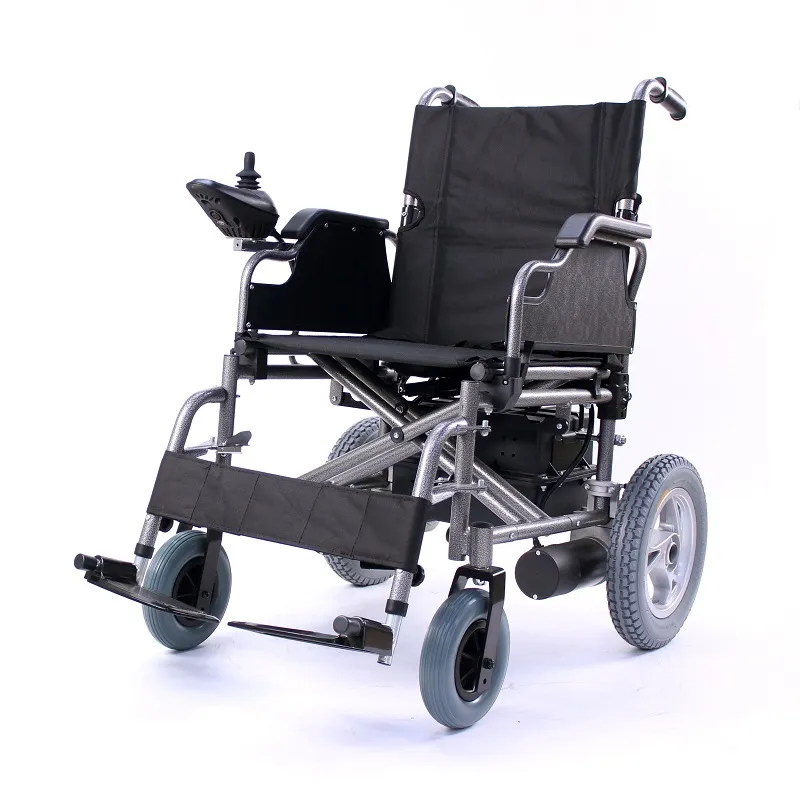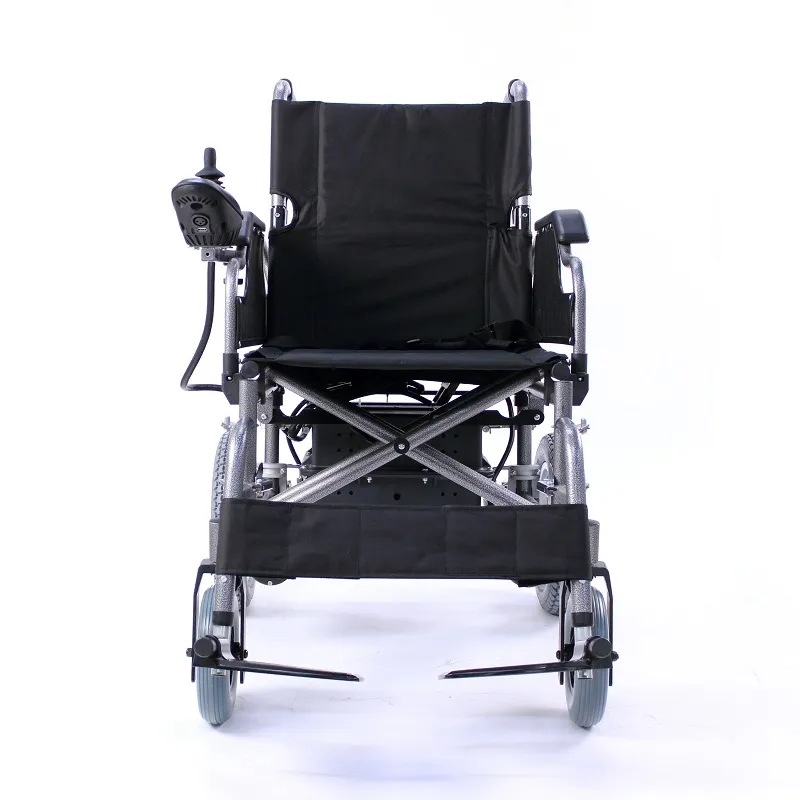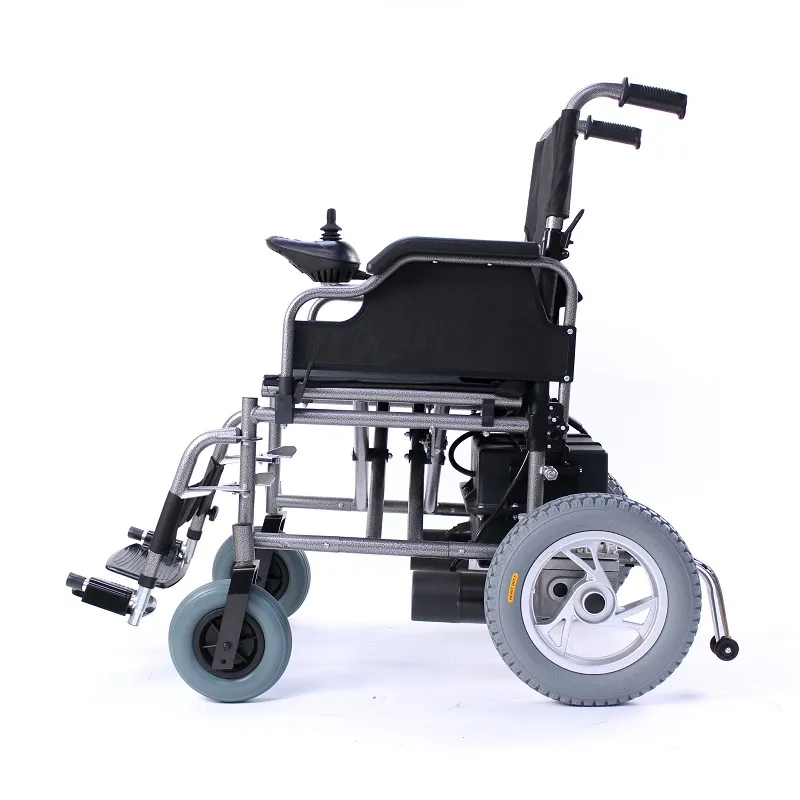As users shift their focus from "lightweight travel" to "reliable load-bearing," they often encounter the question: Why are some electric wheelchairs, seemingly bulky and difficult to carry, still widely used in hospitals, long-term care facilities, and for heavier users?
This article will analyze each aspect from the perspectives of structural materials, power and battery, chassis and wheel assembly, functional configuration, safety/standard requirements, manufacturing, and cost. Using a manufacturer's actual product (Dayang's heavy-duty steel all-terrain electric wheelchair) as an example, this article will help readers understand "weight" as an inevitable result of design choices and clinical needs, rather than a simple design flaw.

How much does Dayang's "heavy-duty steel electric wheelchair" weigh?
Dayang's Heavy Duty Steel All Terrain Electric Wheelchair (model DY01110A) has specifications for "powder-coated steel frame, semi-foldable design, 12-inch rear wheels," "weight: 51.72 kg, load capacity: 100 kg." Dayang combines a high-strength steel frame, a foldable structure, and an all-electric drive system into a single vehicle, weighing nearly 52 kg. This product is positioned as a practical model for outdoor off-road use and those requiring high stability.
The first factor: Steel is significantly heavier than aluminum. Weight is determined from the source.
The frame material is the most direct factor determining the "raw weight" of a wheelchair. A comparison of the densities of common metal materials clearly shows that typical steel has a density of approximately 7.7–8.0 g/cm³, while aluminum alloys have a density of approximately 2.6–2.8 g/cm³—in other words, steel is approximately three times heavier than aluminum for the same volume.
Thus, the primary "heaviness" of a heavy-duty steel electric wheelchair stems from the fundamental decision to use steel as its load-bearing frame. Designers typically choose steel to achieve higher load capacity, rigidity, and impact resistance.
Load-bearing design determines the materials and structure—"heavy load-bearing capacity means thicker, heavier structure."
The keywords "heavy-duty steel electric wheelchair" contain both "heavy" and "steel." The term "heavy-duty" refers not only to the overall weight but, more importantly, to the load-bearing capacity (bariatric/heavy-duty). To increase the rated load from the typical 100–120 kg to 200 kg or even higher, manufacturers must use larger materials and more reinforcements in the frame, joints, folding hinges, welds, axles, suspension, and seat mounts, all of which increase the overall weight.
Common heavy-duty/bariatric wheelchairs offered by medical suppliers utilize "thickened steel tubing, double cross bracing, and a wider wheelbase" to enhance stability and fatigue life, at the expense of increased weight.
For example, Dayang's product specifications display "high-strength steel frame," "foldable design," "100 kg load capacity, 51.72 kg overall weight." This combination of values indicates that the manufacturer has to use stronger and heavier components to ensure "off-road stability and seat comfort." This is an engineering necessity for applications requiring traversal over uneven terrain or supporting heavier users.

The Second Key Factor: Powertrain and Battery—The Motor and Power Supply Are the "Invisible Contributors to Weight"
In addition to the frame, the electric system (motor, gears, controller) and power supply (battery) are another major contributor to the weight of an electric wheelchair:
• Motor and Drive System: To achieve strong gradeability, off-road traction, or higher load torque, heavy-duty electric wheelchairs typically use higher-powered motors and reduction gearboxes. A single high-torque motor typically weighs several kilograms (some commercial wheelchair motors are marked at approximately 2–3 kg per unit). Heavy-duty configurations may use dual motors or even larger motors, significantly increasing the weight of the entire powertrain.
• Battery: Lead-acid or sealed lead-acid batteries traditionally used in electric wheelchairs are large and heavy—a typical set of lead-acid batteries can weigh 16–30 kg. Modern lithium-ion batteries, while offering the same energy content, are significantly lighter (perhaps only a few to over ten kilograms). However, lithium-ion battery solutions that achieve "long driving range, support heavy loads, and frequent starts and stops" are costly.
The third factor: chassis, wheels, tires, and suspension—off-road/heavy-load applications require a more robust chassis.
Heavy steel electric wheelchairs are typically used for outdoor or all-terrain use, so their chassis, wheels, and suspension designs are more complex than those of lightweight indoor models. Larger rear wheels, wider front casters, solid or semi-solid large-diameter tires, thicker spline bearings, and stronger axles and shock absorbers all add weight—this is to maintain stability on uneven surfaces, reduce vibration transmission, and improve riding safety. For example, Dayang's product page states it's equipped with "200×50 PU front small wheels and 12-inch PU rear wheels," specifications specifically designed for durability and off-road capability.
In addition, heavy-duty wheelchairs often feature anti-roll wheels, reinforced brakes, and gear ratio adjustment for hill climbing, all of which contribute to weight. In other words, the more a wheelchair is designed to be "uphill, downhill, and heavy," the heavier the removable and heaviest parts are.

The fourth factor: Seats, armrests, and additional features—comfort and medical functions also carry weight.
To meet the needs of long-term seating, pressure distribution, and medical transfer, heavy-duty steel electric wheelchairs are often equipped with thicker seat cushions, removable or liftable armrests, adjustable backrests, flip-up armrests, and independent leg rests. These features come at the expense of patient comfort and ease of care.
Many hospital-grade multi-functional electric wheelchairs also integrate hydraulic transfer/lifting, a removable co-seat, electric tilt/rollover, or waterproofing. These functional modules themselves significantly increase the weight of the device. Dayang's product features list features such as flip-up armrests, removable leg rests, and a semi-folding backrest, all of which contribute to weight.
Electric Wheelchairs: Why is "Heavy" an Advantage?
Although heavy-duty steel electric wheelchairs may not meet the requirements for single-person transport and travel convenience, the engineering and clinical value of their weight cannot be ignored:
• Greater stability and rollover resistance: A higher mass and lower center of gravity naturally improve static and dynamic stability, making them especially safer when off-road or carrying heavy loads.
• Longer load-bearing capacity and structural life: Thicker steel and enhanced welding can extend the fatigue life of the structure and reduce the risk of plastic deformation and failure under heavy loads.
• Ease of maintenance and cost advantages: Steel is easy to weld, repair, and replace (especially in resource-limited settings), and its repair network and cost are more user-friendly than lightweight alloys or carbon fiber.
• Price and availability: Steel and traditional manufacturing processes are mature and relatively low-cost, making heavy-duty steel electric wheelchairs more competitively priced and easier for long-term care facilities to purchase in bulk.
Electric wheelchairs: How to strike a balance between "weight" and "lightness"?
Users often have two major pain points when purchasing an electric wheelchair: (A) I need a wheelchair that can bear heavy loads and is sturdy and durable; (B) I also want it to be easy to carry in a car, on trips, or even on an airplane. In reality, these two goals can conflict with each other, but some compromises can be achieved through the following strategies:
• Modular decomposition: Choose a model that can be disassembled into several components (frame + battery + seat + wheels), with the heaviest component within a transportable range. Many heavy-duty wheelchairs have a heaviest disassembled component weighing 30–40 kg, while portable travel chairs can weigh even less.
• Battery Strategy: Using lithium batteries instead of lead-acid batteries can significantly reduce weight while maintaining or improving battery life, but this is more expensive and requires compliance with UN38.3 testing specifications for air transport. For frequent travel with high load requirements, a vehicle-mounted lift platform can be considered instead of placing the wheelchair in the trunk.
• Material and Structural Optimization: Some modern products utilize a hybrid structure of "steel + partial aluminum alloy/composite materials," combining strength and cost advantages with lightweight requirements, meeting load requirements while also reducing some of the weight.

Is a "heavy-duty steel electric wheelchair" so heavy?
One-sentence answer and decision-making recommendations:
—To meet higher bariatric load requirements, off-road stability, safety standards, and electric power and range requirements, engineers must use high-density (heavier) materials (such as steel), larger and heavier batteries and motors, a sturdier chassis and wheels, and more comfort and medical features; all of this adds up to the "heavy" factor. Dayang's heavy-duty steel model (approximately 51.72 kg, with a 100 kg payload) is a practical example of this design trade-off.
Three quick tips for hospital purchasers and home users:
1. If your primary needs are "weight bearing capacity/durability/off-road capability," consider a heavy-duty steel electric wheelchair that's "heavier but more stable" and equipped with carrying and lifting equipment.
2. If your primary needs are "convenient travel/single-person transport/airplane portability," prioritize lightweight or mixed-material models and confirm the battery (lithium) and the "heaviest single component" after disassembly.
3. Before purchasing, be sure to request third-party testing standards (ISO 7176, EN 12184/RESNA, or manufacturer's test report), a battery UN38.3 report, and after-sales service guarantees to thoroughly evaluate functionality, weight, and maintenance costs.
What support do you provide for customized packaging?
We offer OEM packaging services, including printed boxes, barcode labeling, instruction manuals in multiple languages, and brand-specific color schemes. Custom packaging is available for wheelchairs, walkers, commodes, and more. For bulk orders, we also provide design templates and quote-based recommendations to optimize cost and appearance.










